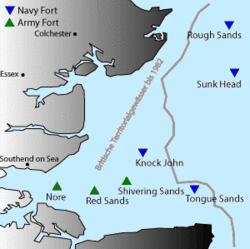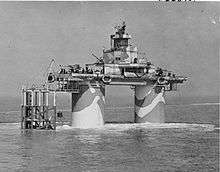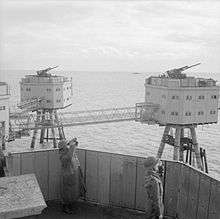Maunsell Forts
| Maunsell Sea Forts | |
|---|---|
| Thames and Mersey estuaries | |
|
"Army" style fort (Red Sands) | |
|
"Navy" style fort (Knock John) | |
| Type | Fortified towers |
| Height | Approx 30 feet (9.1 m)-78 feet (24 m) |
| Site information | |
| Owner |
|
| Open to the public | Yes, in some cases |
| Condition | Decommissioned in the late 1950s |
| Site history | |
| Built | 1942–1943 |
| In use | Second World War |
| Materials | Concrete, metals |
| Events | Used during Second World War |
The Maunsell Forts are armed towers built in the Thames and Mersey estuaries during the Second World War to help defend the United Kingdom. They were operated as army and navy forts, and named after their designer, Guy Maunsell.[1] The forts were decommissioned in the late 1950s and later used for other activities including pirate radio broadcasting. One of the forts is managed by the unrecognised Principality of Sealand; boats visit the remaining forts occasionally, and a consortium called Project Redsands is planning to conserve the fort situated at Red Sands. In the summers of 2007 and 2008 Red Sands Radio, a station commemorating the pirate radio stations of the 1960s, operated from the Red Sands fort on 28-day Restricted Service Licences. The fort was subsequently declared unsafe, and Red Sands Radio has moved its operations ashore to Whitstable.
Previously, forts had been built in UK rivermouths etc. to defend against ships, such as the Grain Tower Battery at the mouth of the Medway dating from 1855, Plymouth Breakwater Fort, completed 1865, the four Spithead Forts: Horse Sand Fort, No Mans Land and St Helens Forts which were built 1865-80; and Spitbank Fort, built in the 1880s,[2] the Humber Forts on Bull & Haile Sands, completed in late 1919, and the Nab Tower, intended as part of a World War I anti-submarine defence but only set in place in 1920.
Maunsell naval forts
The Maunsell naval (sea) forts, built in the Thames estuary and operated by the Royal Navy, were to deter and report German air raids following the Thames as a landmark, and attempts to lay mines by aircraft in this important shipping channel.


There were four naval forts:
- Rough Sands (HM Fort Roughs) (U1)
- Sunk Head (U2)
- Tongue Sands (U3)
- Knock John (U4)
The design of these concrete structures is equal to a military grade bunker, due to the ends of the stilts, (under water) that are solidly locked into the ground. Many species of fish live near the forts because the forts create cover. They have provided landmark references for shipping.
The design was a concrete construction: a pontoon barge on which stood two cylindrical towers on top of which was the gun platform mounting two 3.75-inch guns and two 40 mm Bofors guns. They were laid down in dry dock and assembled as complete units. They were then fitted out—the crews going on board at the same time for familiarization—before being towed out and sunk onto their sand bank positions in 1942.[1]
The naval fort design was the latest of several that Maunsell had devised in response to Admiralty inquiries. Early ideas had considered forts in the English Channel able to take on enemy vessels.[1]

Maunsell army forts

Maunsell also designed forts for anti-aircraft defence. These were larger installations comprising seven interconnected steel platforms. Four towers carried QF 3.75 inch guns arranged in a semicircle ahead of the control centre and accommodation, a tower to the rear of the control centre mounted Bofors 40 mm guns, while the seventh tower, set to one side of the gun towers and further out, was the searchlight tower.
Three forts were placed in Liverpool Bay:[3][4]
- Queens AA Towers
- Formby AA Towers
- Burbo AA Towers
and three in the Thames estuary:
- Nore (U5),
- Red Sands (U6)
- Shivering Sands (U7)
Each of these AA forts carried four QF 3.75 inch guns and two Bofors 40 mm guns. The Mersey forts were constructed at Bromborough Dock,[5] the Thames forts at Gravesend.[6]
During World War II, the Thames estuary forts shot down 22 aircraft and about 30 flying bombs.
They were decommissioned by the Ministry of Defence in the late 1950s.
Red Sands
There are 7 forts in the Red Sands group, at the mouth of the Thames Estuary. These forts were previously connected by metal grate walk-ways.
Shivering Sands
This group was built near the Thames estuary for anti-aircraft defence, and made-up of several towers north of Herne Bay and 9.2 miles from the nearest land.
Fort histories
Thames Estuary Army Forts
Nore Army Fort was badly damaged in 1953 when the Norwegian ship Baalbek collided with it, destroying two of the towers, killing four civilians and destroying guns, radar equipment and supplies. The ruins were considered a hazard to shipping and dismantled in 1959–60. Parts of the bases were towed ashore by the Cliffe fort at Alpha wharf near the village of Cliffe, Kent, where they were still visible in 2006.
One of the Shivering Sands towers was lost in 1963 after a ship collided with it. In 1964 the Port of London Authority placed wind and tide monitoring equipment on the Shivering Sands searchlight tower, which was isolated from the rest of the fort by the demolished tower. This relayed data to the mainland via a radio link.
In August and September 2005, artist Stephen Turner spent six weeks living alone in the searchlight tower of the Shivering Sands Fort in what he described as "an artistic exploration of isolation, investigating how one's experience of time changes in isolation, and what creative contemplation means in a 21st-century context".[7]
Navy Forts
Sunk Head was destroyed by the Royal Engineers in the late 1960s.
Tongue Fort collapsed in a storm in 1996.
Pirate radio stations
Various forts were re-occupied for pirate radio in the mid-1960s.
In 1964, a few months after Radio Caroline went on air, Screaming Lord Sutch set up Radio Sutch in one of the towers at Shivering Sands. Sutch soon became bored with the project and sold the station to his manager Reginald Calvert who renamed the station Radio City and expanded operations into all of the five towers that remained connected. Calvert's killing in a dispute over the station's ownership (found to be self-defence rather than murder) contributed to the Government passing legislation against the pirates in 1967.
During the pirate era the Port of London Authority frequently complained that its monitoring radio link was being disrupted by the nearby Radio City transmitter.

Red Sands was likewise occupied by Radio Invicta, which was renamed KING Radio and then Radio 390, after its wavelength of approximately 390 metres. The station's managing director was ex-spy and thriller writer Ted Allbeury.
The size of the Army forts made them ideal antenna platforms, since a large antenna could be based on the central tower and guyed from the surrounding towers.
A small group of radio enthusiasts set up Radio Tower on Sunk Head Naval fort, but the station was run on a shoestring, had poor coverage and lasted only a few months. Claims by the group that they also intended to run a television service from the fort were never credible. In order to prevent further pirate broadcasting, a team of Royal Engineers laid 2,200 lbs of explosive charges on Sunk Head, commencing on 18 August 1967. At 4:18 PM on 21 August the charges were detonated, destroying the entire superstructure and most of the concrete legs above the waterline.[8]
Paddy Roy Bates occupied the Rough Sands Fort and set up Radio Essex, later renamed BBMS—Britain's Better Music Station—but was better known for his post-pirate activities. He, or a representative, has lived in Roughs Tower since 1964, self-styling the tower as the Principality of Sealand.[9]
Cultural references
The 1965 Danger Man episode "Not-so-Jolly Roger" was partly filmed at Red Sands and includes an acknowledgement to Radio 390 in its closing credits. Red Sands was also used for the 1968 Doctor Who serial Fury from the Deep, in which the complex stood in for a North Sea gas refinery besieged by an intelligent seaweed creature.
The Shivering Sands Forts, filmed from a North Sea ferry, appeared in the 1984 music video for the song A Sort of Homecoming, by the Irish pop music band U2.[10]
See also
- Admiralty M-N Scheme
- Sea fort
- Palmerston Forts – including several Sea Forts built on pre-existing islands or rocky islets, as well as some built directly upon the seabed
- Texas Towers
References
- 1 2 3 Whitstable Scene: The Maunsell Sea Forts
- ↑ ECastles reference to the Spithead Forts
- ↑ Turner (1995), p. 84.
- ↑ Thread on WorldNavalShips.com giving more details of the forts
- ↑ Turner (1995), p. 18.
- ↑ Turner (1995), p. 90.
- ↑ Stephen Turner's artistic exploration of the Shivering Sands Fort
- ↑ Bishop, Gerry (1975). Offshore Radio. Iceni Enterprises, Norwich. ISBN 0-904603-00-8.
- ↑ The Principality of Sealand
- ↑ 'A Sort of Homecoming' video on Youtube (3.38-3.42 minutes) https://www.youtube.com/watch?v=dZoX7yiTpiU
Further reading
- Turner, Frank R. (1995). The Maunsell Sea Forts. (3 volumes, ISBN 0-9524303-0-4; ISBN 0-9524303-1-2; ISBN 0-9524303-7-1). ISBN 0-9524303-0-4.
- Kauffmann, J.E. and Jurga, Robert M. Fortress Europe: European Fortifications of World War II, Da Capo Press, 2002. ISBN 0-306-81174-X
External links
| Wikimedia Commons has media related to Maunsell Forts. |
- Maunsell Sea Forts information
- Guide to Sea Forts from HerneBayOnline
- Project Redsand from project-redsand.com
- Red Sands Radio official website
- Maunsell Towers from undergroundkent.co.uk
- Map of the Forts from BenvenutiaSealand.it (English version via Google Translate)

